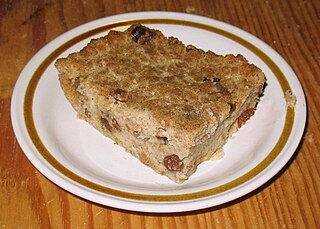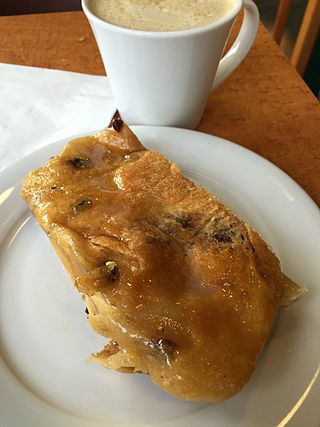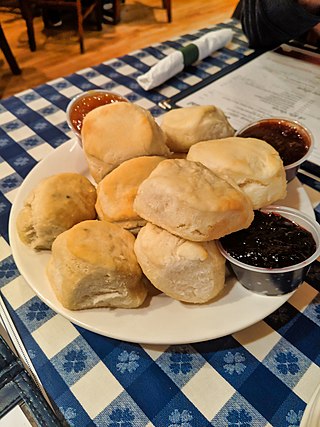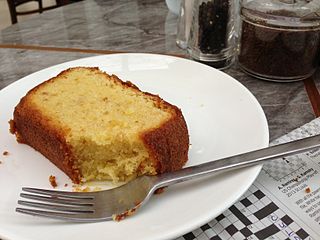Related Research Articles

Bread pudding is a bread-based dessert popular in many countries' cuisines. It is made with stale bread and milk or cream, generally containing eggs, a form of fat such as oil, butter or suet and, depending on whether the pudding is sweet or savory, a variety of other ingredients. Sweet bread puddings may use sugar, syrup, honey, dried fruit, nuts, as well as spices such as cinnamon, nutmeg, mace, or vanilla. The bread is soaked in the liquids, mixed with the other ingredients, and baked.

Cake is a flour confection made from flour, sugar, and other ingredients and is usually baked. In their oldest forms, cakes were modifications of bread, but cakes now cover a wide range of preparations that can be simple or elaborate and which share features with desserts such as pastries, meringues, custards, and pies.

Malay cuisine is the traditional food of the ethnic Malays of Southeast Asia, residing in modern-day Malaysia, Indonesia, Singapore, Brunei, Southern Thailand and the Philippines as well as Cocos Islands, Christmas Island, Sri Lanka and South Africa.

Fruitcake or fruit cake is a cake made with candied or dried fruit, nuts, and spices, and optionally soaked in spirits. In the United Kingdom, certain rich versions may be iced and decorated.

A cinnamon roll is a sweet roll commonly served in Northern Europe and North America. In Sweden it is called kanelbulle, in Denmark it is known as kanelsnegl, in Norway it is known as kanelbolle, skillingsbolle, kanelsnurr, or kanel i svingene, in Finland it is known as korvapuusti, in Iceland it is known as kanilsnúður, and in Estonia it is known as kaneelirull. In Austria and Germany, it is called Zimtschnecke. In Slovakia and the Czech Republic, it is called osie hniezdo/vosí hnízdo.

Pennsylvania Dutch cuisine is the typical and traditional fare of the Pennsylvania Dutch.

A Bundt cake is a cake that is baked in a Bundt pan, shaping it into a distinctive donut shape. The shape is inspired by a traditional European cake known as Gugelhupf, but Bundt cakes are not generally associated with any single recipe. The style of mold in North America was popularized in the 1950s and 1960s, after cookware manufacturer Nordic Ware trademarked the name "Bundt" and began producing Bundt pans from cast aluminum. Publicity from Pillsbury saw the cakes gain widespread popularity.

Sri Lankan cuisine is known for its particular combinations of herbs, spices, fish, vegetables, rices, and fruits. The cuisine is highly centered around many varieties of rice, as well as coconut which is a ubiquitous plant throughout the country. Seafood also plays a significant role in the cuisine, be it fresh fish or preserved fish. As a country that was a hub in the historic oceanic silk road, contact with foreign traders brought new food items and cultural influences in addition to the local traditions of the country's ethnic groups, all of which have helped shape Sri Lankan cuisine. Influences from Indian, Indonesian and Dutch cuisines are most evident with Sri Lankan cuisine sharing close ties to other neighbouring South and Southeast Asian cuisines.

An ontbijtkoek, peperkoek or kruidkoek is a Dutch and Flemish spiced cake. Rye and dark brown basterdsuiker are its most important ingredient, coloring the cake light brown. It is often spiced with cloves, cinnamon, ginger, succade and nutmeg. Several parts of the Netherlands have their own local recipe, of which the most famous is oudewijvenkoek, which is mostly eaten in the northern regions, and is flavored with aniseed. Ontbijtkoek is traditionally served at breakfast with a thick layer of butter on top, as a replacement for bread, however, due to its sweet taste it is also served as a snack. It is best eaten the day after it is baked, but has a shelve life of several weeks at room temperatures, without it spoiling, due to the pH, sugar content and used spices.

An appa or appam is a type of thin pancake originating from South India and Sri Lanka. It is made with fermented rice batter and coconut milk, traditionally cooked in an appachatti, a deep pan similar in shape to a wok. It is part of Tamil cuisine and Kerala cuisine found in the Indian states of Tamil Nadu and Kerala, and in Sri Lanka. Appam is most frequently served for breakfast or dinner, often with a topping such as an egg.

In many European countries, particularly in Central and Eastern Europe, there are various traditions surrounding the use of bread during the Easter holidays. Traditionally the practice of eating Easter bread or sweetened "communion" bread traces its origin back to Byzantium, Eastern Catholicism and the Orthodox Christian church. The recipe for sweetened or "honey-leavened" bread may date back as far as the Homeric Greek period based on anecdotal evidence from classical texts.

Coffee cake or coffeecake is a sweet bread common in the United States, so called because it is typically served with coffee. Leavenings can include yeast, baking soda, or baking powder. The modern dish typically contains no coffee.

Lardy cake, also known as lardy bread, lardy Johns, dough cake and fourses cake, is a traditional spiced bread enriched with lard and found in several southern counties of England, including Sussex, Surrey, Hampshire, Berkshire, Wiltshire, Dorset and Gloucestershire, each claiming to be the original source. It remains a popular weekend tea cake.
Potato cake is a name given to various shaped potato dishes around the world, including a patty of hashed potatoes, a fried patty of mashed potato, a fried and battered slice of potato, or a flatbread made with mashed potato and flour. In Northern England and some states in Australia, a thin slice of potato that is battered and deep fried may be called a potato scallop. In Australia and New Zealand, the terms potato cake, potato flip and potato fritter may be used.

In the United States, a biscuit is a variety of baked bread with a firm, dry exterior and a soft, crumbly interior. In Canada it sometimes also refers to this or a traditional European biscuit. It is made with baking powder as a leavening agent rather than yeast, and at times is called a baking powder biscuit to differentiate it from other types. Like other forms of bread, a biscuit is often served with butter or other condiments, flavored with other ingredients, or combined with other types of food to make sandwiches or other dishes.

Sponge cake is a light cake made with eggs, flour and sugar, sometimes leavened with baking powder. Some sponge cakes do not contain egg yolks, like angel food cake, but most of them do. Sponge cakes, leavened with beaten eggs, originated during the Renaissance, possibly in Spain. The sponge cake is thought to be one of the first non-yeasted cakes, and the earliest attested sponge cake recipe in English is found in a book by the English poet Gervase Markham, The English Huswife, Containing the Inward and Outward Virtues Which Ought to Be in a Complete Woman (1615). Still, the cake was much more like a cracker: thin and crispy. Sponge cakes became the cake recognised today when bakers started using beaten eggs as a rising agent in the mid-18th century. The Victorian creation of baking powder by English food manufacturer Alfred Bird in 1843 allowed the addition of butter to the traditional sponge recipe, resulting in the creation of the Victoria sponge. Cakes are available in many flavours and have many recipes as well. Sponge cakes have become snack cakes via the Twinkie.

Love cake or Bolo di Amor, is a type of semolina cake eaten in Sri Lanka on special occasions. They are often baked for cultural celebrations such as Christmas, birthdays and weddings, served wrapped in gold paper for guests to eat or take home.

Sugee cake is a cake made of semolina and almonds, creamed butter, eggs, and brandy, and optionally covered in marzipan and royal icing. The cake is typically baked during festive occasions and holidays like Christmas, by members of Malaccan Portuguese in Malacca and the larger Eurasian community in Malaysia and Singapore. The word sugee has its origins in Hindustani word for 'semolina'. Sugee cake is similar to the Sri Lankan Love cake baked during Christmas by the Eurasian Burgher people, which uses cashew as opposed to almonds.[9]
References
- ↑ Bullis, Douglas; Hutton, Wendy (2001). Food of Sri Lanka. Tuttle Publishing. p. 18. ISBN 9781462907182.
- ↑ Kelegama, Thiruni. "Frikkadels and lamprais: The best of Burgher cooking". The Sunday Times . Retrieved 14 November 2019.
- ↑ "Breudher". Glorious Food Glossary. Glorious Food. Retrieved 16 November 2019.
- ↑ Priyadershini, S. (31 August 2017). "Bundt it like breudher". The Hindu . Retrieved 18 November 2019.
- ↑ Tan, Christopher (2015). NerdBaker: Extraordinary Recipes, Stories & Baking Adventures from a True Oven Geek. Epigram Books. ISBN 9789814615761.
- ↑ Bullis, Douglas; Hutton, Wendy (2014). Sri Lankan Cooking. Tuttle Publishing. ISBN 9781462905775.
- ↑ "Your guide to eating well this Christmas". The Sunday Morning. 9 December 2018. Retrieved 16 November 2019.
- ↑ Hansen, Barbara (3 December 1992). "Ethnic Cooking : Poffertjes of the Season". LA Times . Retrieved 18 November 2019.
- ↑ Reeves, Peter, ed. (2013). The Encyclopedia of the Sri Lankan Diaspora. Editions Didier Millet. p. 43. ISBN 9789814260831.
- ↑ Farrer, James, ed. (2015). The Globalization of Asian Cuisines: Transnational Networks and Culinary. Springer. ISBN 9781137514080.
- ↑ Ng, Sheere (11 April 2018). "The Double Deaths of Toddy and Bluder Cake". Tuck Shop. Retrieved 16 November 2019.
- ↑ Pereira, Alexius A. (2016). Singapore Eurasians: Memories, Hopes And Dreams. World Scientific. p. 254. ISBN 9789813109612.
- 1 2 Rajoo, Ananya. "The Story of a Dutch Bread called Breudher". Route Cochin. Retrieved 19 November 2019.
- ↑ Thomas, Elizabeth (24 September 2017). "Tracing Breudher". Deccan Chronicle . Retrieved 19 November 2019.
- ↑ Kenneison, Rebecca (2013). Playing for Malaya. Flipside Digital Content Company Inc. ISBN 9789971697327.